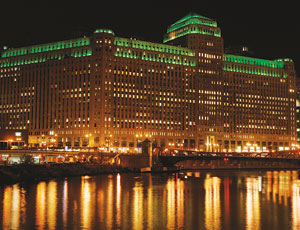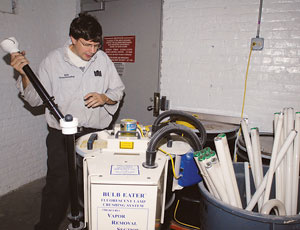As the recession grinds on, some consultants are finding an emerging outlet by updating older buildings from power hogs into green stewards. The trend is attracting a fresh round of eco-savvy tenants.
Chicago is home to two large projects, examples of advancing efforts to green up existing buildings. In early December, 172 buildings nationwide were certified under the U.S. Green Building Council’s LEED for Existing Buildings Rating System, a program created in 2004. More than 2,000 other buildings are seeking to obtain such certification, according to the Washington, D.C.-based group.


Chicago holds claim to the world’s largest commercial building, and now the largest rated under LEED-EB. Built in 1930, the behemoth Merchandise Mart is attracting a new generation of tenants focused on green standards. “We got started on the idea of becoming LEED certified after many of our tenants were pursuing the certification [for their own build-outs],” says Myron Maurer, senior vice president of operations for the 4.2-million-sq-ft facility. The supertall Sears Tower, built in 1974, is next on the list in a project that could cost $150 million, according to published reports.
Although the Mart’s managers set out with visions of green roofs and mechanical change-outs, certification typically calls for less-drastic measures. “It isn’t so much about the project as it is about process,” Maurer says. The investigation began in early 2006 and certification came in November 2007, thanks in part to a grant from an initative led by the William J. Clinton Foundation, which also is helping fund the Sears job.
Merchandise Mart hired Chicago-based nonprofit Delta Institute to navigate the checklist, costing about $200,000. That led to rewriting the facility’s construction and operating guides, under which $1 million in capital improvements were made in 2006-07. “Everything we purchase and every contractor we work with has to have the right sustainable products,” says Lloyd Davidson, vice president of construction services. “We’re changing the way the building operates, from capital construction to tenant construction and from how we clean the floors to the kind of light bulbs we use and our choice of carpet.”
The effort worked. “Overall there has been a 10% decrease in energy usage, and the Mart has pledged to make another 10% reduction by the end of 2010,” Davidson says. Its occupancy rate also is in the mid-90 percentile. “We have 3.5-million sq ft of rental space,” explains Mark Bettin, vice president of engineering. “Being LEED certified has helped us retain existing tenants and has garnered interest from new tenants.”
Sears’ managers are working with local Adrian Smith + Gordon Gill Architecture on a LEED-EB rating. Among its improvements may include installation of the tallest green roof in the U.S. Chicago’s large stock of middle-aged buildings, like Sears, is especially ripe for greening because many already need renovations and mechanical upgrades, notes Robert Forest, AS+GG managing partner. “Nobody wants to go to a building that’s out of date or unhealthy.”

Post a comment to this article
Report Abusive Comment